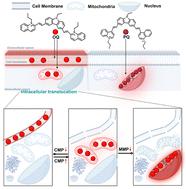当前位置:
X-MOL 学术
›
J. Mater. Chem. B
›
论文详情
Our official English website, www.x-mol.net, welcomes your feedback! (Note: you will need to create a separate account there.)
A translocation fluorescent probe for analyzing cellular physiological parameters in neurological disease models
Journal of Materials Chemistry B ( IF 7 ) Pub Date : 2024-04-15 , DOI: 10.1039/d4tb00557k Zilu Li , Ai-Xin Ma , Jing-Qi Liu , Kun Wang , Baocun Zhu , Dai-Wen Pang , Deming Kong
Journal of Materials Chemistry B ( IF 7 ) Pub Date : 2024-04-15 , DOI: 10.1039/d4tb00557k Zilu Li , Ai-Xin Ma , Jing-Qi Liu , Kun Wang , Baocun Zhu , Dai-Wen Pang , Deming Kong

|
Neurological disorders are closely linked to the alterations in cell membrane permeability (CMP) and mitochondrial membrane potential (MMP). Changes in CMP and MMP may lead to damage and death of nerve cells, thus triggering the onset and progression of neurological diseases. Therefore, monitoring the changes of these two physiological parameters not only benefits the accurate assessment of nerve cell health status, but also enables providing key information for the diagnosis and treatment of neurological diseases. However, the simultaneous monitoring of these two cellular physiological parameters is still challenging. Herein, we design and synthesize two quinolinium-carbazole-derivated fluorescent probes (OQ and PQ). As isomers, the only difference in their chemical structures is the linking position of the carbazole unit in quinoline rings. Strikingly, such a subtle difference endows OQ and PQ with significantly different organelle-staining behaviors. PQ mainly targets at the nucleus, OQ can simultaneously stain cell membranes and mitochondria in normal cells, and performs CMP and MMP-dependent translocation from the cell membrane to mitochondria then to the nucleus, thus holding great promise as an intracellular translocation probe to image the changes of CMP and MMP. After unraveling the intrinsic mechanism of their different translocation abilities by combining experiments with molecular dynamics simulations and density functional theory calculations, we successfully used OQ to monitor the continuous changes of CMP and MMP in three neurological disease-related cell models, including oxidative stress-damaged, Parkinson's disease, and virus-infected ones. Besides providing a validated imaging tool for monitoring cellular physiological parameters, this work paves a promising route for designing intracellular translocation probes to analyze cellular physiological parameters associated with various diseases.
中文翻译:

用于分析神经疾病模型中细胞生理参数的易位荧光探针
神经系统疾病与细胞膜通透性(CMP)和线粒体膜电位(MMP)的改变密切相关。 CMP和MMP的变化可能导致神经细胞的损伤和死亡,从而引发神经系统疾病的发生和进展。因此,监测这两个生理参数的变化不仅有利于准确评估神经细胞的健康状态,而且可以为神经系统疾病的诊断和治疗提供关键信息。然而,同时监测这两种细胞生理参数仍然具有挑战性。在这里,我们设计并合成了两种喹啉鎓咔唑衍生的荧光探针(OQ和PQ)。作为异构体,它们化学结构的唯一区别是咔唑单元在喹啉环中的连接位置。引人注目的是,这种微妙的差异赋予OQ和PQ显着不同的细胞器染色行为。PQ主要针对细胞核,OQ可以同时对正常细胞的细胞膜和线粒体进行染色,并进行CMP和MMP依赖性的从细胞膜到线粒体再到细胞核的易位,因此作为细胞内易位探针具有广阔的前景。 CMP 和 MMP 的变化。通过结合实验与分子动力学模拟和密度泛函理论计算揭示了它们不同易位能力的内在机制后,我们成功地利用OQ监测了三种神经疾病相关细胞模型中CMP和MMP的连续变化,包括氧化应激损伤、帕金森病和病毒感染者。除了提供用于监测细胞生理参数的经过验证的成像工具外,这项工作还为设计细胞内易位探针来分析与各种疾病相关的细胞生理参数铺平了一条有前途的途径。
更新日期:2024-04-15
中文翻译:

用于分析神经疾病模型中细胞生理参数的易位荧光探针
神经系统疾病与细胞膜通透性(CMP)和线粒体膜电位(MMP)的改变密切相关。 CMP和MMP的变化可能导致神经细胞的损伤和死亡,从而引发神经系统疾病的发生和进展。因此,监测这两个生理参数的变化不仅有利于准确评估神经细胞的健康状态,而且可以为神经系统疾病的诊断和治疗提供关键信息。然而,同时监测这两种细胞生理参数仍然具有挑战性。在这里,我们设计并合成了两种喹啉鎓咔唑衍生的荧光探针(OQ和PQ)。作为异构体,它们化学结构的唯一区别是咔唑单元在喹啉环中的连接位置。引人注目的是,这种微妙的差异赋予OQ和PQ显着不同的细胞器染色行为。PQ主要针对细胞核,OQ可以同时对正常细胞的细胞膜和线粒体进行染色,并进行CMP和MMP依赖性的从细胞膜到线粒体再到细胞核的易位,因此作为细胞内易位探针具有广阔的前景。 CMP 和 MMP 的变化。通过结合实验与分子动力学模拟和密度泛函理论计算揭示了它们不同易位能力的内在机制后,我们成功地利用OQ监测了三种神经疾病相关细胞模型中CMP和MMP的连续变化,包括氧化应激损伤、帕金森病和病毒感染者。除了提供用于监测细胞生理参数的经过验证的成像工具外,这项工作还为设计细胞内易位探针来分析与各种疾病相关的细胞生理参数铺平了一条有前途的途径。



























 京公网安备 11010802027423号
京公网安备 11010802027423号